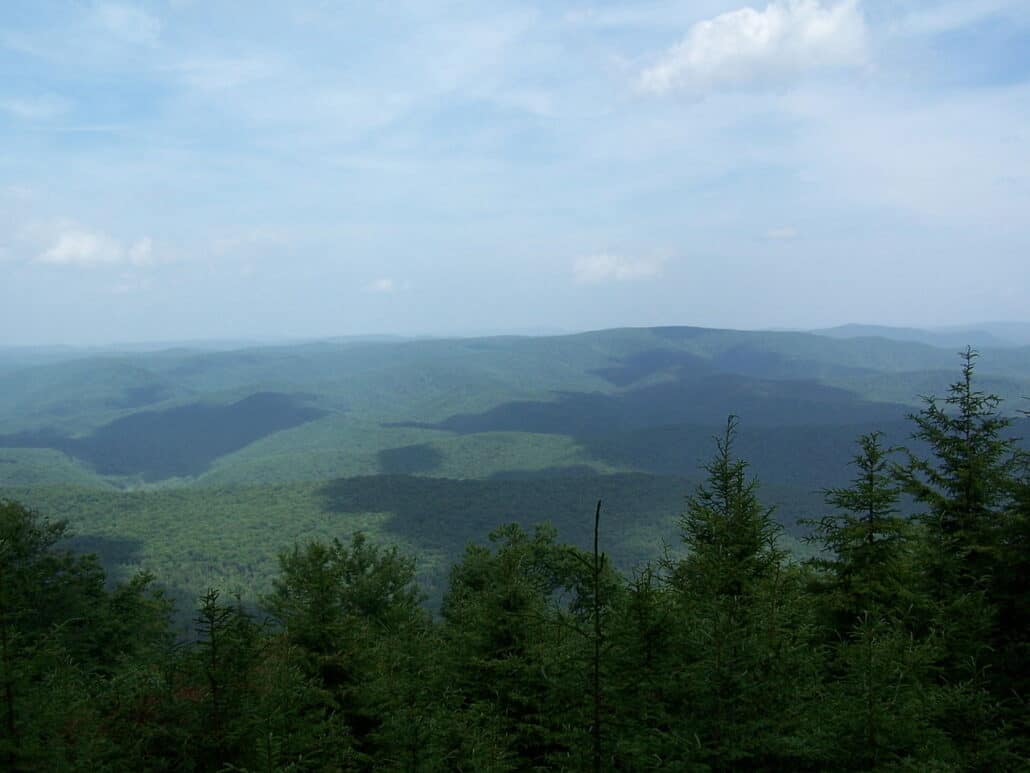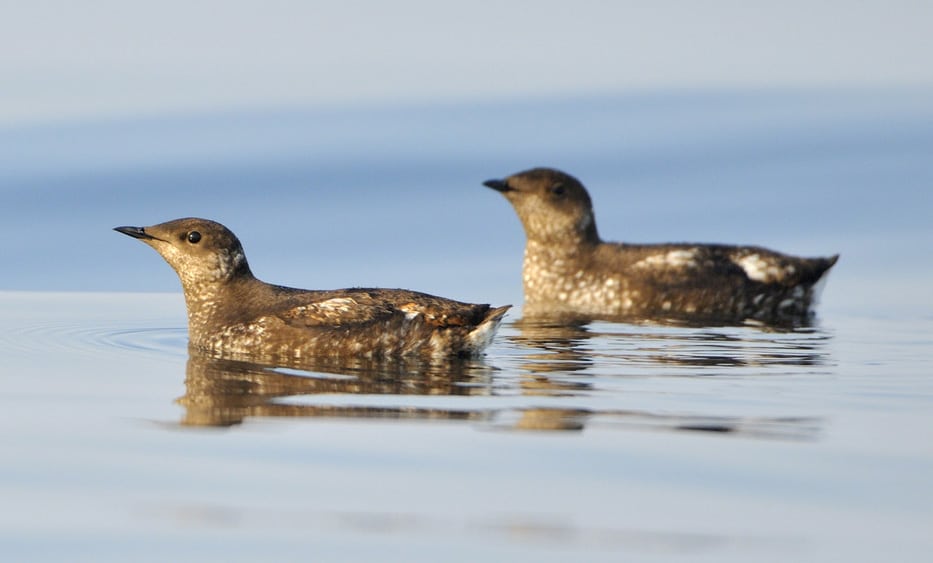There’s a spruce-clad knob located in the mountains of West Virginia, 4,445 feet above sea level, that is unusual in various ways. It’s Gaudineer Knob on Shavers Mountain, a part of the Cheat Mountain range, and named for Don Gaudineer, a forest ranger in the Monongahela National Forest, who lost his life 1936 trying to rescue his children from a fire.
One of the reasons Guadineer is special for bird watchers is that it is possible on the mountain to hear four species of brown-backed thrushes in concert during late May, June, and early July: the hermit, Swainson’s, and wood thrushes, and the veery. These thrushes are four of the foremost avian songsters in the eastern United States, and they all occur in and about the red spruce zone on the Randolph-Pocahontas county line near Cheat Bridge. Elevation, topography, climatic conditions, and stages of vegetation are among the factors that influence the distribution of these birds at Gaudineer. It’s an ideal spot to get acquainted with their songs and to learn the difference in their vocalizations.
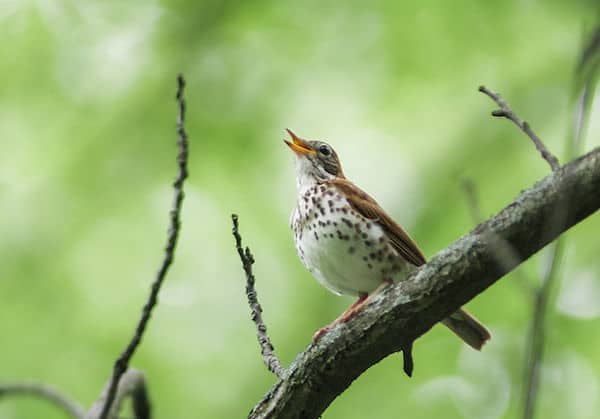
The wood thrush is absent in some years. I heard it in 1993, but not in 1994. In his book West Virginia Birds, Dr. George A. Hall discusses the relationship of the four species, saying that the wood thrush is most often found in “dense mature deciduous forest. . .even in the highest elevations. It also occurs in the mixed spruce-northern hardwoods but is absent from the pure spruce. . . . At the higher elevations, this species comes in contact with at least two and possibly three of the Catharus species [the veery and the hermit and Swainson’s thrushes; the wood thrush’s genus is Hylocichia]. In warbler, dark-eyed junco, winter wren, magnolia warbler, and purple finch. A short trail through the picnic area leads to a scenic vista, and if one spends enough time here the reward may be the song of the mourning warbler and a glimpse of it as it skulks in and out among the brush and brambles. To me the voice of the mourning warbler has a ventriloquistic quality. Sometimes when I hear it I search the underbrush. Then, as I cautiously creep toward the spot where I think it is, I realize it is actually overhead on a dead limb, watching me. Just when I raise my binoculars to look at it, the bird usually plummets for cover.

Another feature of Gaudineer is a 140-acre tract that the Forest Service has designated as a scenic area and a registered natural landmark. It’s just a little more than a mile from the picnic area on the knob and is often referred to as the virgin spruce area. An interpretative nature trail takes the visitor back to a representation of the forest primeval. Individual trees here range up to 40 inches in diameter at breast height and up to 300 years old. (The site is where members of the Brooks Bird Club, a West Virginia-based organization, found in 1948 the first nest of the brown creeper in the state.)
In June 1982, at the parking lot that leads to the nature trail, I saw a Nashville warbler carrying a tiny, wriggling caterpillar in its mouth, thus indicating that this is possibly another of six or seven places where the species nests in the Mountain State.
When I first visited Gaudineer in 1941, a fire tower stood sentinel atop the knob. The spruce forest below was young, virtually a solid wall, an impenetrable barrier 10 to 20 feet tall. A veteran birder who has made many visits to the area says that back then “you had to crawl through on your hands and knees, and then you couldn’t get very far.” Now, more than 50 years later, some of the first limbs are 20 feet high. Compared with the majestic monarchs seen on the trail through the virgin forest, the trunks here seem spindly. To me the red spruce zone in eastern North America is, in some respects, like the rain forest of the tropics.
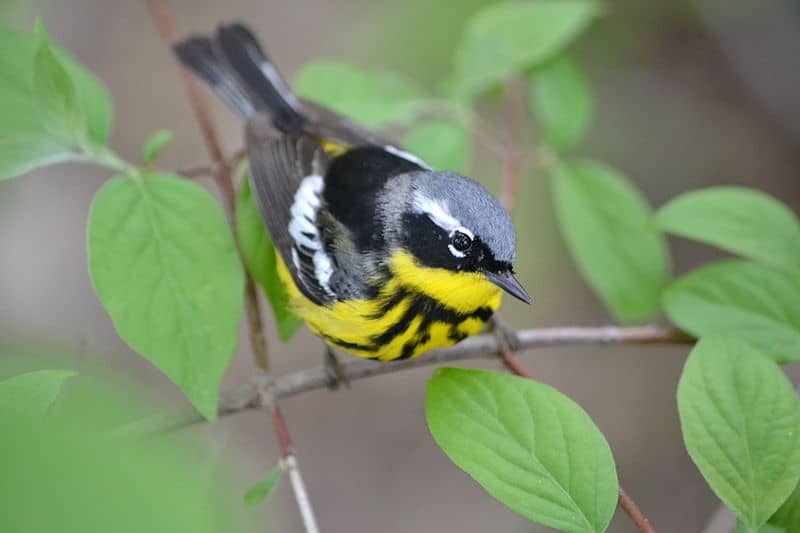
The young spruces in the 1940s were a haven for the winter wren and the magnolia warbler. It seemed as if the latter was never out of sight or hearing. As a beginning bird watcher then, I heard every magnolia that sang differently. Today both species are present; however, it’s my impression that they are not as abundant as they once were. The magnolia population has declined, but the wren is still relatively common.
In the 1940s, according to studies made Dr. John H. Aldrich of the U.S. Fish and Wildlife Service, the Cheat Mountain Range, of which the Gaudineer area is a part, had one of the highest populations of birds per acre in the United States. Undoubtedly, the density of the spruce and mountain laurel was a contributing factor.
Before the tower was dismantled, a visit to the top on a pleasant evening in mid-June, with the sun sinking, still tingeing the sky pink, and a full moon rising, bordered on the ethereal. One could see a 360-degree, awe-inspiring panorama of ridge after ridge, some misty, some looking as if they were bathed in smoke. And, as accompaniment, a symphony of thrushes could be heard. Common nighthawks boomed, performing their aerial acrobatics at eye level. Chimney swifts, with nests in their ancestral home of big hollow trees in this wilderness, wheeled about, maneuvering back and forth.
The demolition of the fire tower eliminated a notable experience, but the combination of elements that make for special bird watching on the knob remains—only the night-hawks are missing, their absence possibly due to depletion of suitable habitat.
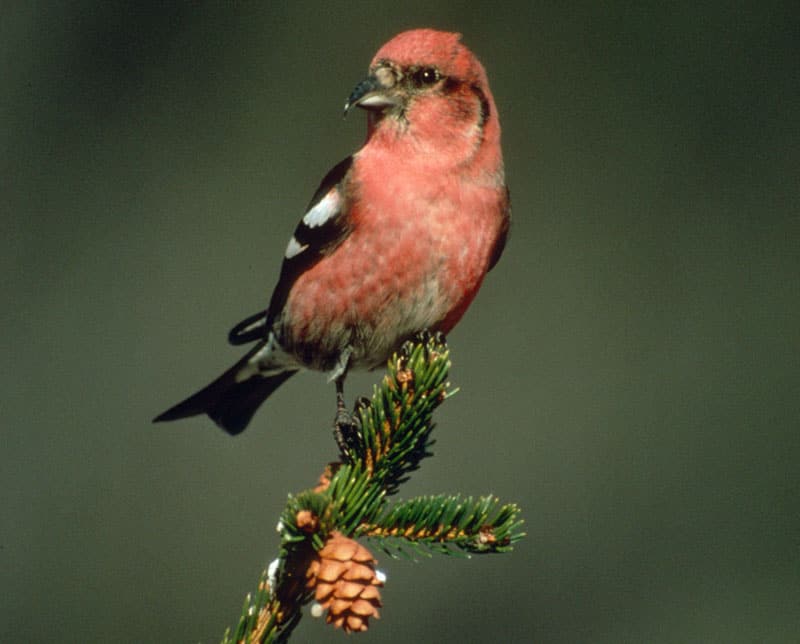
The nomadic crossbill, which follows the production of conifer seeds, is likely to be observed at Gaudineer at any time. Both the red-winged and the white-winged species have been recorded. The pine siskin has been found in summer. Wood warblers one might encounter in addition to those mentioned earlier are the black-and-white, Blackburnian, black-throated blue, black-throated green, hooded, Canada, and chestnut-sided, as well as the yellowthroat, the ovenbird, and the northern waterthrush. In The Appalachians, the late Maurice Brooks wrote that at Gaudineer, “from the foot of the mountain to its summit 22 warbler species are summer residents, more kinds than are known to nest on any other Appalachian peak.”\

You can expect, but are not guaranteed, the raven, barred and saw-whet owls, turkey, ruffed grouse, and red-tailed, red-shouldered, Cooper’s, and sharp-shinned hawks. The olive-sided flycatcher has been observed sporadically in summer.
The best time to go bird watching is of course early morning, especially if you are looking for thrushes. But on Guadineer I prefer the cool of the evening—there is usually less vehicular traffic creating sound in the distance then, and the refrains of thrushes seem more pronounced.
There are interesting species other than birds present. The Cheat Mountain salamander, Plethodon nettingi, was a species new to science when it was discovered in 1935 on White Top Mountain, a knob about three miles from Gaudineer. According to Dr. Thomas K. Pauley, coauthor of Amphibians and Reptiles in West Virginia, the small, golden-flecked, glistening creature occurs in the Gaudineer area and the higher elevations of several of the surrounding counties.
Historical Sites of Interest
The area also has an interesting human history. Important Civil War sites are scattered throughout the forest. On the east side of Cheat Bridge a roadside marker labeled “Cheat Summit Camp” provides a capsule history of the area, concluding with the fact that at 4,000 feet in elevation, this camp was the highest Union fort in the Civil War. One the west side of the bridge a road leads up to this site, and trail signs interpret the scene, explaining the Federal and Confederate troops suffered as many losses here from the weather and disease as they did on the battlefield.
Botanical Features

Of botanical interest, plants new to science were discovered by Asa Gray (famous Harvard botanist, and author of the great Manual of Botany) as he crossed Cheat Mountain by way of the Staunton-Parkersburg Turnpike in August 1843. High-country flora that can be seen on Gaudineer include witherod, also called hobblebush or alder-leaved viburnum (Virburnum alnifolium). Present also are the red-berried elder, rhododendron (West Virginia’s state flower), and mountain laurel. Other noteworthy plants are the “deciduous” hollies and the mountain ash, which flaunt their brilliant red berries in the fall and winter, and the magnolias, which show off their beauty in the spring. Intermingled with the spruces are the northern hard-woods—American beech, yellow birch, sugar maple, and other allied deciduous species, plus hemlock and the often overlooked striped maple.
At Gaudineer Knob’s elevation, north meets south, and the visitor may find flora and fauna that match species more often associated with northern New England and eastern Canada. This boreal island in the Appalachians has fascinated me for more than half a century.

